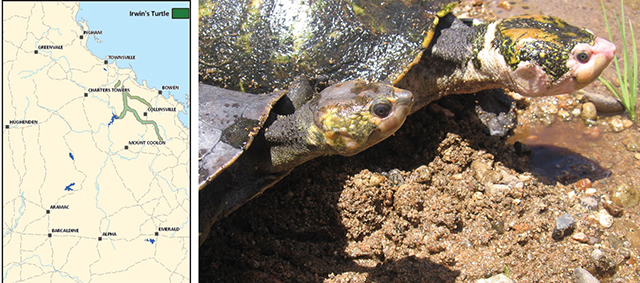Irwin’s turtle, yellow-headed snapping turtle (Elseya irwini)
What do they look like? Irwin’s Turtle is a medium-sized snapping turtle, whose shell can be up to 30 cm long. It has a short neck and pale, white-pinkish head, the facial colouring making it look as though it’s wearing a pale mask. Snapping turtles, including Irwin’s Turtle, differ from other short necked turtles in having two large, fleshy barbels under the chin.
Where do they live? Irwin’s Turtles live in clear, though often turbulent parts of the Burdekin River and its various tributaries. They are most common below rapids.
What do they need to live, eat and breed? Irwin’s Turtles feeds on aquatic invertebrates and may take water plants and the fruit of land plants. They nest in friable soil along riverbanks. They are one of a few species of turtles known to ‘bum-breathe’ – take in oxygen through the rear end. This may explain why they are most common in the more oxygenated water found below rapids.
When might I see (or hear) them? Irwin’s Turtles are not common, but are most likely to be seen when they bask on logs or rocks in the sun on cooler mornings.
What management actions affect this species? Irwin’s Turtles are unlikely to survive in silted water and are vulnerable to predation by pigs and foxes, particularly when nesting. Maintain ground cover and vigorous native pastures across the catchment to avoid sediment movement and siltation of river channels. Riverbanks are special areas for Irwin’s Turtle, so maintain healthy, native riparian vegetation which works as a silt trap and provides food for the turtle. Control introduced riverbank weeds and feral predators and avoid disturbing riverbanks with machinery where nests may occur.
How do they benefit the land I manage? Presence of Irwin’s Turtles is an indicator of good river water quality. Low silt levels and adequate aeration are also important for fish stocks and the health of down-stream environments, including the Great Barrier Reef.
Similar species: Long-necked turtles (Chelodina spp.), other short-necked turtles (Emydura and Elseya spp.)


